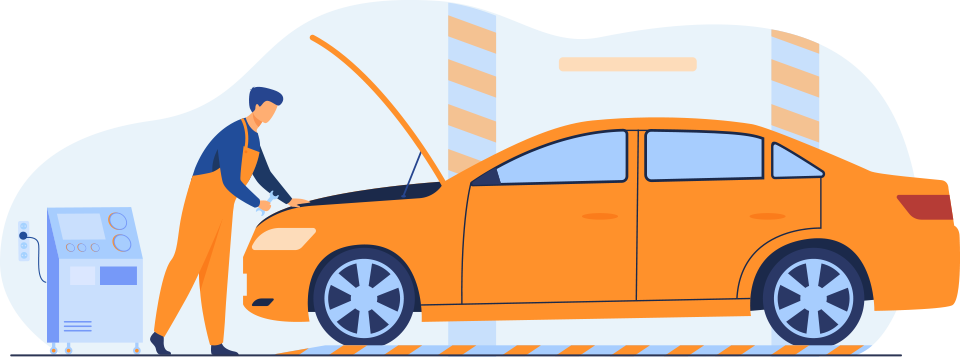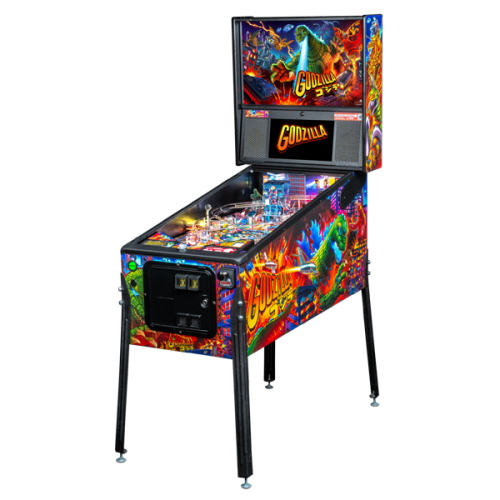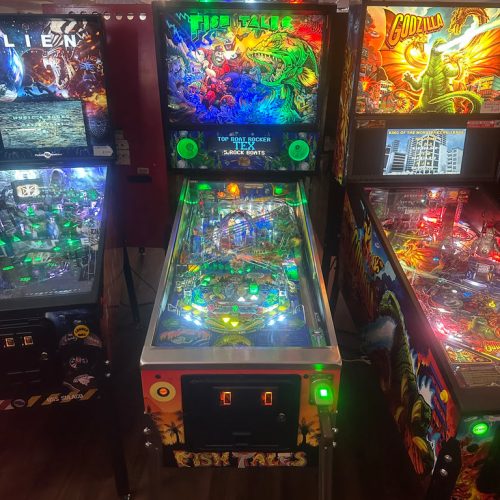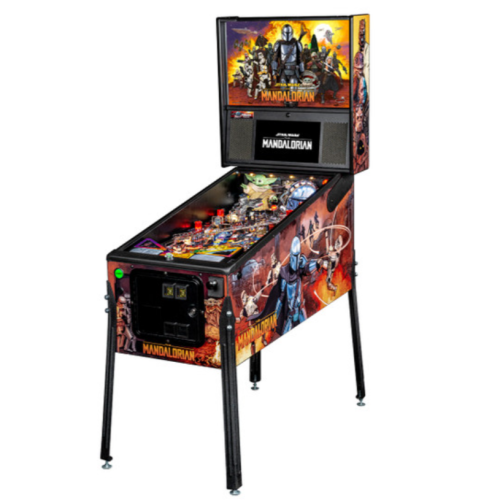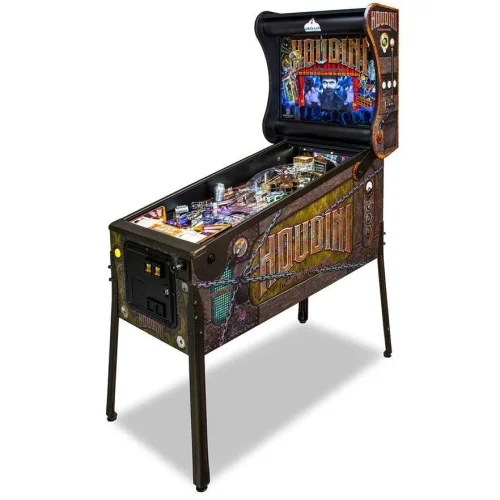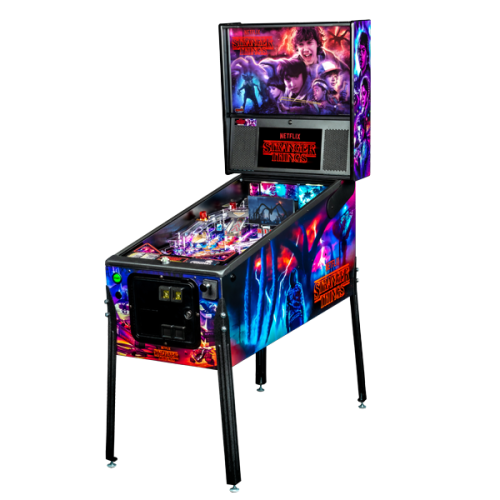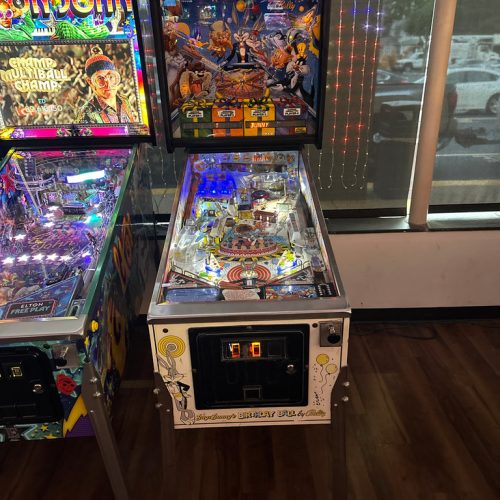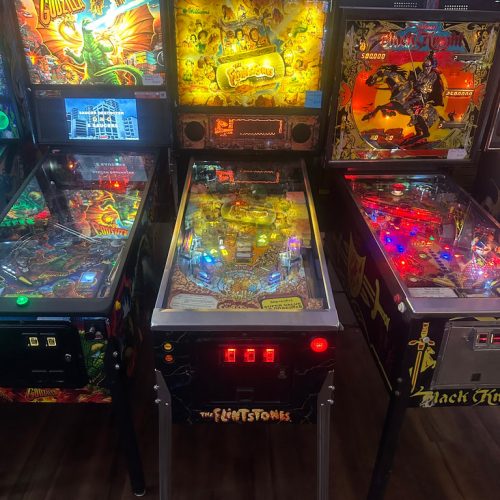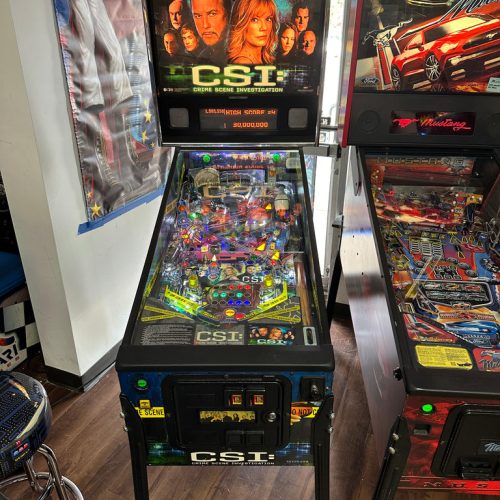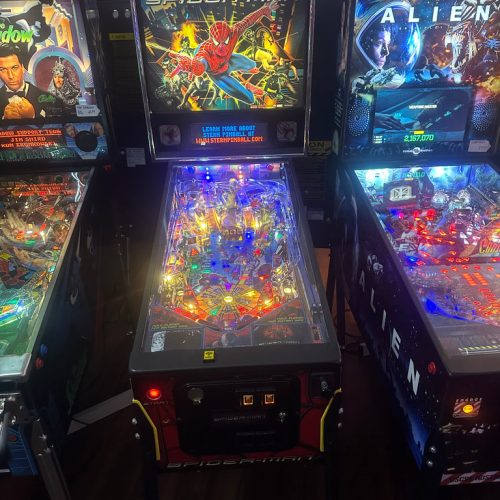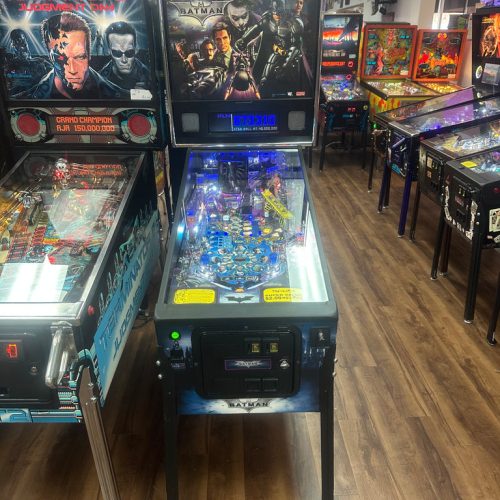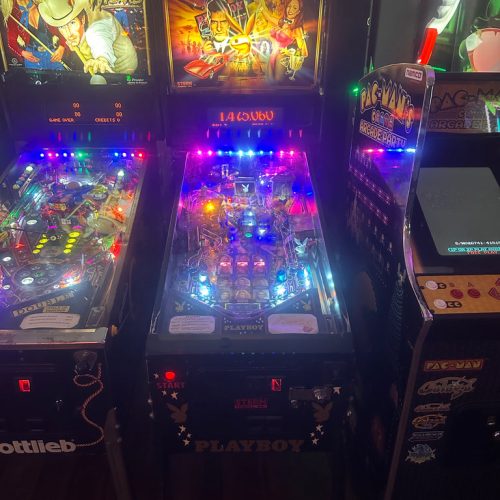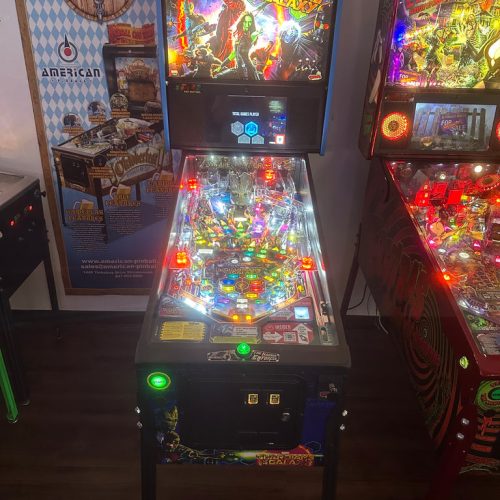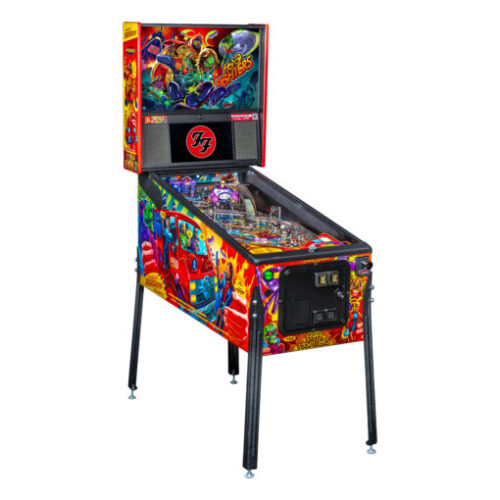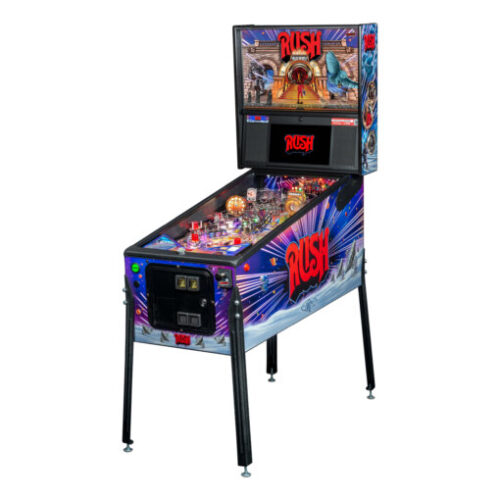If you are a fan of arcade games, you might have played or seen a pinball machine. Pinball machines are coin-operated games that use metal balls, flippers, bumpers, lights, and sounds to create a fun and challenging experience for players. Pinball machines are not only entertaining, but also have a rich and fascinating history, a complex and creative design, and a diverse and competitive market. In this review, we will explore all these aspects of pinball machines and help you find the best places to get them.
History of Pinball Machines
The origins of pinball machines can be traced back to the 18th century, when games like croquet and billiards were played outdoors by rolling balls or stones on a grass course. These games eventually evolved into indoor versions that could be played on a table or on the floor of a pub. One of these games was bagatelle, which was invented in France and involved hitting balls with a cue stick into holes on a narrow wooden board. Bagatelle was popular among the aristocracy and even among royalty, such as Louis XIV and Marie Antoinette.
In 1871, a British inventor named Montague Redgrave patented an improved version of bagatelle, which he called “Improvements in Bagatelle”. He made the game smaller, replaced the large balls with marbles, added a coiled spring and a plunger to launch the balls, and tilted the board to create an inclined playfield. These features would later become essential elements of pinball machines.
The first pinball machines appeared in mass during the early 1930s as counter-top machines without legs. They were inspired by Redgrave’s invention and by another game called billard japonais, which used metal pins instead of holes as targets. The first coin-operated pinball game was Bally Hoo, which was invented by Raymond T. Maloney, the founder of the Bally Corporation. The term “pinball” itself was not used until 1936.
Pinball machines soon became popular in arcades, bars, and candy stores across America. They were also constantly improved and innovated by various manufacturers and designers. Some of the milestones in pinball history include:
- The tilt mechanism, which was invented in 1934 by Harry Williams to prevent players from shaking or lifting the machines.
- The electric lights and sounds, which were introduced in 1934 by Harry Williams and other manufacturers to make the games more attractive and exciting.
- The bumper, which was invented in 1937 by Bally Hoo and consisted of a rubber ring that would bounce the ball back when hit.
- The flipper, which was invented in 1947 by Harry Mabs and Wayne Neyens for Gottlieb’s Humpty Dumpty game. The flipper was a movable paddle that allowed players to control the ball’s direction and speed.
- The multi-ball feature, which was introduced in 1962 by Williams’ Vagabond game. It allowed players to play with more than one ball at a time, increasing the challenge and the score potential.
- The solid-state electronics, which replaced the mechanical relays and switches in 1976 with Williams’ Hot Tip game. This enabled more complex and reliable gameplay, as well as digital displays and sound effects.
- The dot-matrix display (DMD), which replaced the numeric displays in 1991 with Data East’s Checkpoint game. It allowed for more detailed graphics and animations on the backglass.
- The video mode, which was introduced in 1992 by Williams’ The Machine: Bride of Pinbot game. It allowed players to play mini-games on the DMD using the flippers as controllers.
Pinball machines reached their peak of popularity in the 1990s, when they competed with video games for arcade space and customers. However, they also faced challenges such as rising production costs, declining revenues, legal restrictions, and changing consumer tastes. By the end of the decade, only one major manufacturer remained: Stern Pinball.
How Pinball Machines Work
Pinball machines are complex devices that combine mechanical, electrical, and electronic components to create an interactive game. A typical pinball machine consists of four main parts: the cabinet, the playfield, the backbox, and the coin mechanism.
The Cabinet
The cabinet is the wooden box that houses most of the components of the pinball machine. It has four legs that support its weight and allow it to stand upright. It also has two buttons on each side that control the flippers on the playfield. The front of the cabinet has a coin door that allows access to the coin mechanism and other service parts. The back of the cabinet has a power cord that connects it to an electrical outlet.
The Playfield
The playfield is the main area where the game takes place. It is a flat sheet of wood or metal that is covered with a layer of clear plastic or glass to protect it from wear and tear. It is also decorated with artwork, lights, targets, ramps, toys, and other features that vary depending on the theme and design of each game.
The playfield is tilted at an angle of about 6 to 7 degrees from horizontal to allow gravity to move the ball down towards the drain hole at the bottom center. The player can prevent this by using the flippers to hit the ball back up towards the top of the playfield.
The playfield has several sensors that detect when the ball hits certain targets or passes through certain areas. These sensors are connected to switches or optos that send signals to a central processing unit (CPU) that controls the game logic. The CPU then activates various lights, sounds, solenoids (electromagnets), motors (electric motors), or relays (electrical switches) that affect the gameplay.
Some examples of common playfield features are:
- The plunger: A spring-loaded rod that launches the ball into play when pulled back and released by the player.
- The flippers: Two or more paddles that can be moved up or down by pressing buttons on each side of the cabinet. The flippers are usually controlled by solenoids that are activated by the buttons.
- The slingshots: Two rubber-covered bumpers that are located on each side of the drain. They are also controlled by solenoids and kick the ball away when hit.
- The pop bumpers: Three or more round bumpers that are located near the top of the playfield. They are also controlled by solenoids and light up and make noise when hit. They also score points for each hit.
- The drop targets: Rectangular targets that are arranged in rows or columns. They drop down when hit and score points. Sometimes they also light up or trigger other features when all of them are down.
- The stand-up targets: Circular or triangular targets that are fixed on the playfield. They score points when hit and sometimes light up or trigger other features.
- The ramps: Curved or straight metal or plastic tracks that elevate the ball to another level of the playfield or to a mini-playfield. They score points when the ball passes through them and sometimes trigger other features.
- The loops: Circular or oval paths that send the ball around the playfield. They score points when the ball completes them and sometimes trigger other features.
- The orbits: Straight paths that send the ball from one side of the playfield to the other. They score points when the ball passes through them and sometimes trigger other features.
- The spinner: A metal or plastic disc that spins when hit by the ball. It scores points for each spin and sometimes triggers other features.
- The rollover: A small hole or switch that is activated when the ball rolls over it. It scores points and sometimes triggers other features.
- The kickout hole: A small hole that catches the ball and then ejects it after a short delay. It scores points and sometimes triggers other features.
- The scoop: A large hole that catches the ball and then ejects it to another location on the playfield. It scores points and sometimes triggers other features.
- The lock: A device that holds one or more balls in place until a certain condition is met, such as starting a multi-ball mode.
- The diverter: A device that changes the direction of the ball when it passes through a certain path, such as a ramp or an orbit.
- The magnet: A device that attracts or repels the ball using an electromagnet, creating unpredictable movements and effects.
- The toy: A device that interacts with the ball in a thematic way, such as a moving figure, a spinning wheel, a video screen, or a mechanical contraption.
The Backbox
The backbox is the vertical part of the pinball machine that is attached to the top of the cabinet. It contains several components that are essential for the game’s operation and display.
The most visible component of the backbox is the backglass, which is a sheet of glass or plastic that is printed with artwork related to the game’s theme. Behind the backglass, there are various lights that illuminate different parts of the artwork depending on the game’s progress and events.
The backbox also contains one or more displays that show information such as scores, credits, messages, animations, and mini-games. Depending on the era and model of the pinball machine, these displays can be numeric (using light bulbs or LEDs), alphanumeric (using vacuum fluorescent displays), dot-matrix (using plasma displays), or LCD (using liquid crystal displays).
The backbox also houses the main controller board, which is a circuit board that contains the CPU, memory, sound chips, input/output ports, and other components that control the game. The main controller board communicates with other boards that are located in the cabinet and the playfield, such as the power supply board, the sound board, the display board, and the driver board.
The Coin Mechanism
The coin mechanism is the device that accepts coins or tokens and allows the game to start. It consists of a coin slot, a coin acceptor, a coin switch, and a coin box. The coin slot is the opening where the player inserts the coin or token. The coin acceptor is a device that detects the size, shape, weight, and metal composition of the coin or token and determines if it is valid or not. The coin switch is a device that sends a signal to the main controller board when a valid coin or token is accepted. The coin box is a container that collects the coins or tokens that are accepted.
The coin mechanism can be set to accept different types of coins or tokens depending on the location and preference of the operator. Some pinball machines also have a bill acceptor that accepts paper money instead of or in addition to coins or tokens.
How Pinball Machines Are Designed
Pinball machines are designed by teams of creative professionals who work together to create a game that is fun, challenging, and appealing to players. The design process involves several steps, such as:
- Licensing and prototyping: The first step is to choose a theme for the game, which can be based on an original idea, a movie, a TV show, a band, a comic book, or anything else that can attract players. Sometimes, the theme requires licensing from another company or entity, which can involve negotiations and contracts. The design team then works on developing a game concept, which includes the layout of the playfield, the features of the game, and the rules of the game. They also create prototype parts and software to test their ideas and make adjustments as needed.
- Sketches and templates: The next step is to create sketches and templates for the artwork of the game, which includes the backglass, the playfield, the cabinet, and any other parts that need graphics. The artwork has to match the theme and style of the game and also be attractive and eye-catching. The sketches and templates have to be approved by the licensing agency if applicable before they are sent to another company to print them on the actual parts.
- Whitewood prototype: The next step is to create a whitewood prototype, which is a basic version of the pinball machine that has no artwork or electronics. It only has wooden parts and mechanical components that allow testing of the gameplay and functionality of the game. The whitewood prototype is used to check if everything works as intended and to make any changes or improvements as needed.
- Building the machine: The final step is to build the actual pinball machine using all the parts that have been designed and produced. This involves assembling the cabinet, wiring the electronics, installing the playfield, attaching the backglass, and testing the game. The building process can take several weeks or months depending on the complexity and quantity of the game.
How Pinball Machines Are Manufactured
Pinball machines are manufactured by specialized companies that have the equipment and expertise to produce high-quality and reliable products. The manufacturing process involves several steps, such as:
- Ordering and receiving parts: The first step is to order and receive all the parts that are needed to build the pinball machines, such as wood, metal, plastic, glass, electronics, artwork, and hardware. Some parts are made by the pinball company itself, while others are sourced from outside suppliers or contractors. The parts are then inspected and stored in a warehouse until they are needed.
- Cutting and drilling: The next step is to cut and drill the wood and metal parts that form the structure of the cabinet, the playfield, and the backbox. This is done using machines such as saws, routers, drills, and CNC (computer numerical control) machines that can precisely cut and shape the parts according to the design specifications.
- Painting and printing: The next step is to paint and print the artwork on the wood and metal parts that need it, such as the cabinet, the playfield, and the backglass. This is done using machines such as spray guns, rollers, printers, and laminators that can apply colors, images, and protective coatings on the parts.
- Assembling and wiring: The next step is to assemble and wire the parts that form the main components of the pinball machine, such as the cabinet, the playfield, the backbox, and the coin mechanism. This is done using tools such as screwdrivers, wrenches, pliers, soldering irons, and wire strippers that can fasten, connect, and secure the parts together. The wiring process involves connecting all the electrical components of the game, such as lights, switches, solenoids, motors, magnets, sensors, displays, speakers, boards, and power supplies.
- Testing and packing: The final step is to test and pack the pinball machines before they are shipped to customers or distributors. This is done using devices such as multimeters, oscilloscopes, logic analyzers, and software programs that can check if everything works correctly and if there are any errors or defects. The testing process also involves playing the game to ensure that it is fun and challenging. The packing process involves wrapping and securing the pinball machines in cardboard boxes or wooden crates that protect them from damage during transportation.
Best Places to Buy Pinball Machines
If you are interested in buying a pinball machine for your home or business, you might be wondering where to find one. There are several places where you can buy pinball machines online or offline depending on your preferences.
Online
One of the most convenient ways to buy a pinball machine is online. There are many websites that sell new or used pinball machines from various manufacturers and eras. Some of these websites are:
- PinballMachineforSale.net: This website offers a large selection of pinball machines from different brands such as Stern Pinball , Bally , Williams , Gottlieb , Data East , Sega , Jersey Jack Pinball , Chicago Gaming Company , Spooky Pinball , American Pinball , Multimorphic , Homepin , Heighway Pinball , Dutch Pinball , Planetary Pinball , Circus Maximus , Haggis Pinball , Deeproot Pinball , Silver Castle Pinball , Team Pinball , Suncoast Pinball , Quetzal Pinball , Highway Games , VP Cabs , Prime Arcades , AtGames , Toy Shock International , Arcade1Up , Zen Studios , Farsight Studios , Stern Electronics , Capcom , Alvin G & Co . They also offer accessories such as mods , protectors , cleaners , balls , LEDs , manuals , parts, and more. They also offer free shipping and a one-year warranty on most of their products.
Buying online has some advantages such as convenience, variety, and delivery. However, it also has some disadvantages such as high prices, shipping costs, risk of damage or fraud, and lack of personal inspection. Therefore, it is important to do some research before buying online and to choose a reputable and reliable seller.
Offline
Another way to buy a pinball machine is offline. There are some places where you can find new or used pinball machines in person such as:
- Arcades: Arcades are places where you can play various video games and pinball machines for a fee. Some arcades may also sell new or used pinball machines that they no longer need or want. You can find arcades near you by searching online or using apps such as Pinfinder or Pin Map. Buying from arcades has some advantages such as testing the game before buying, negotiating the price, and supporting local businesses. However, it also has some disadvantages such as limited selection, high prices, and lack of warranty or service.
- Dealers: Dealers are people or companies that specialize in selling new or used pinball machines. Some dealers may have physical stores where you can visit and see their inventory while others may only operate online or by appointment. Buying from dealers has some advantages such as wide selection, professional service, and warranty or guarantee. However, it also has some disadvantages such as high prices, shipping costs, and risk of fraud or dishonesty.
- Shows: Shows are events where pinball enthusiasts gather to display, play, buy, sell, trade, or repair pinball machines. Some shows may be local while others may be regional or national. Buying from shows has some advantages such as meeting other pinball fans, finding rare or unique games, and getting good deals. However, it also has some disadvantages such as limited availability, transportation costs, and lack of warranty or service.
Pros and Cons of Buying a Pinball Machine
Buying a pinball machine can be a rewarding and enjoyable experience, but it also comes with some challenges and responsibilities. Here are some of the pros and cons of buying a pinball machine:
Pros
- Fun and entertainment: Pinball machines are fun and entertaining games that can provide hours of enjoyment for you and your family or friends. They can also improve your skills such as hand-eye coordination, reflexes, and strategy.
- Collection and hobby: Pinball machines are collectible items that can increase in value over time depending on their rarity, condition, and popularity. They can also be a hobby that allows you to learn more about their history, design, and mechanics.
- Customization and personalization: Pinball machines can be customized and personalized to suit your preferences and style. You can add mods, accessories, lights, sounds, or artwork to make your machine unique and stand out.
- Income and investment: Pinball machines can be a source of income or investment if you rent them out, sell them, or trade them. You can also use them to attract customers or guests to your business or home.
Cons
- Cost and maintenance: Pinball machines are expensive to buy and maintain. They require regular cleaning, lubrication, adjustment, and repair to keep them in good working order. They also consume electricity and may need parts replacement over time.
- Space and noise: Pinball machines are large and heavy devices that require a lot of space to set up and play. They also produce noise that may disturb your neighbors or other people in your household.
- Risk and liability: Pinball machines are fragile and sensitive devices that can be damaged by accidents, vandalism, theft, fire, water, or power surges. They can also cause injury or damage to yourself or others if they malfunction or are mishandled. You may need insurance or legal protection to cover these risks.
Conclusion
Pinball machines are amazing games that combine art, technology, and skill. They have a long and rich history that spans over two centuries. They have a complex and creative design that involves mechanical, electrical, and electronic components. They have a diverse and competitive market that offers various options for buying new or used machines online or offline.
If you are interested in buying a pinball machine for your home or business, you should consider the following factors:
- Your budget: How much are you willing to spend on a pinball machine? Do you have enough money for maintenance and repairs?
- Your space: How much space do you have for a pinball machine? Do you have a suitable location that is safe, accessible, and comfortable?
- Your preference: What kind of pinball machine do you want? Do you prefer digital or physical? Do you like a certain theme or style? Do you want a new or used machine?
- Your seller: Where do you want to buy a pinball machine? Do you trust the seller? Do they offer good service and warranty?
Buying a pinball machine can be a fun and rewarding experience if you do your research and make an informed decision. We hope this guide has helped you learn more about pinball machines and how to buy them. Happy flipping!
